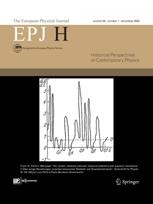A shifting approach to modelling phase transitions
Between the years 1937 and 1970, physicists went from taking a ‘naturalistic’ approach to modelling phase transitions, to a ‘caricature’ approach – which incorporated far less realistic models. New analysis of this period provides new insights into this profound shift in thinking.
New York | Heidelberg, 2 February 2022
 Models of complex physical systems are a central aspect of theoretical physics. Yet despite their importance, there isn’t a single, overarching approach to the practice: meaning researchers in separate branches of physics will rarely use the same methods to construct their models. In one particularly interesting case, approaches for modelling phase transitions underwent a drastic transformation, between the years of 1937 and 1970. In a new paper published in EPJ H, Martin Niss at Roskilde University, Denmark, characterises this fundamental change in thinking.
Models of complex physical systems are a central aspect of theoretical physics. Yet despite their importance, there isn’t a single, overarching approach to the practice: meaning researchers in separate branches of physics will rarely use the same methods to construct their models. In one particularly interesting case, approaches for modelling phase transitions underwent a drastic transformation, between the years of 1937 and 1970. In a new paper published in EPJ H, Martin Niss at Roskilde University, Denmark, characterises this fundamental change in thinking.
During the 1930s, physicists took a ‘naturalistic’ approach to modelling phase transitions – requiring them to observe the processes in real experiments. The aim here was to fully explain the effects being studied, and to show that they exhibit the same features as the models used to study them. As a result, it was expected that models should be highly realistic, and recreate foundational theories as closely as possible. Yet due to the sheer number of microscopic interactions involved, many physicists believed that significant simplifications were needed.
In the 1960s, researchers began to use an alternative ‘caricature’ approach. As well as requiring an explanation of the physical phenomenon in question, this method also aimed to provide better insights into why phase transitions behave as they do. Instead of aspiring for complete realism, the scope of this approach was limited to describing certain aspects of the effect: namely, its behaviour close to critical points, where phase transitions occur. These caricatures can then form the lower levels of a hierarchy of models, where realistic behaviours emerge at the top.
Following the conception of this idea, different groups of physicists took widely differing approaches to characterising phase transitions. This situation persisted until 1971, when a new understanding of statistical mechanics allowed researchers to justify their models in a more advanced way. By documenting this sudden change in thinking, Niss provides new insights into what models can achieve, and their purpose in theoretical physics.
References: M Niss, How to model phase transitions? The changing approaches 1937–1970, EPJ H 46, 25 (2021). https://doi.org/10.1140/epjh/s13129-021-00024-7
Further Information
For more information visit: www.epj.org
Services for Journalists
The full-text articles are available here.
Contact
Sabine Lehr | Springer | Physics Editorial Department
tel +49-6221-487-8336 | sabine.lehr@springer.com
